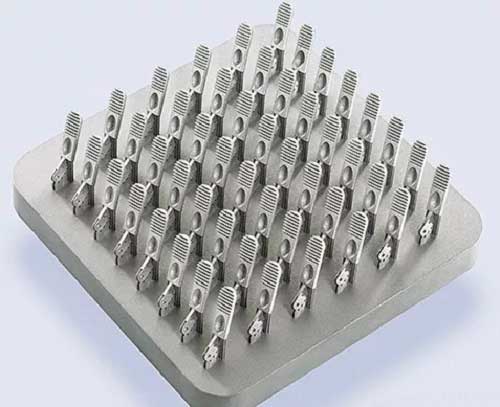Cobalt Chromium Alloy (marketing department of Shanghai HY Industry Co., Ltd)
What is Cobalt Chromium Alloy
-
Cobalt-chromium is a metal alloy of cobalt and chromium. Cobalt-chromium alloys have very high specific strength and are commonly used in gas turbines, dental implants and orthopaedic implants.
The history of cobalt-chromium alloys
-
Co-Cr alloys were first discovered by Elwood Haynes in the early 1900s by fusing cobalt and chromium. The alloy was originally discovered with many other elements such as tungsten and molybdenum. Haynes reported that his alloys were resistant to oxidation and corrosive fumes, with no visible signs of discoloration even when the alloys were exposed to boiling nitric acid. Co-Cr alloys, under the name Stellite, have been used in various fields where high wear resistance is required, including the aerospace industry, tableware, bearings, blades, and more.
-
With the discovery of cobalt-chromium alloys in biomedical applications, it began to receive more attention. In the 20th century, the alloy was first used in the manufacture of medical tools, and the Co-Cr artificial heart valve was first implanted in 1960, which lasted for more than 30 years and showed its high wear resistance. Recently, due to their excellent resistance, biocompatibility, high melting point and incredible high temperature strength, Co-Cr alloys have been used in the manufacture of many artificial joints, including hip and knee joints, bridging work in dental parts, gas turbines, and many other fields.
Synthesis of Cobalt Chromium Alloy
-
Common cobalt-chromium alloy production requires the extraction of cobalt and chromium from cobalt oxide and chromium oxide ores. Both ores need to go through a reduction process to obtain pure metal. Chromium is usually reduced by aluminothermic technology, and pure cobalt can be obtained in a number of different ways, depending on the characteristics of the specific ore. The pure metals are then fused together under vacuum by arc or induction melting. Due to the chemical reactivity of metals at high temperatures, the process requires vacuum conditions or an inert atmosphere to prevent the metal from absorbing oxygen. ASTM F75 is a Co-Cr-Mo alloy produced by spraying molten metal through a small nozzle in an inert argon atmosphere, which is immediately cooled to produce a fine powder of the alloy.
-
However, the synthesis of Co-Cr alloys by the above method is very expensive and difficult. More recently, in 2010, scientists at the University of Cambridge produced this alloy by a novel electrochemical solid-state reduction technique called the FFC Cambridge process, which involves the reduction of an oxide precursor cathode in a molten chloride electrolyte
Properties of Cobalt Chromium Alloys
-
Co-Cr alloys exhibit high corrosion resistance due to the spontaneous formation of a protective passivation film consisting mainly of Cr2O3 and a small amount of cobalt and other metal oxides. Co-Cr alloys are well known for their biocompatibility, as demonstrated by their wide application in the biomedical industry. Biocompatibility also depends on the film and how this oxidized surface interacts with the physiological environment. The good mechanical properties, similar to stainless steels, are the result of the multiphase structure and carbide precipitation, which greatly increases the hardness of Co-Cr alloys. The hardness range of Co-Cr alloy is 550-800MPa, and the tensile strength range is 145-270MPa. Furthermore, tensile and fatigue strengths increase dramatically when they are heat treated. However, cobalt-chromium alloys tend to have low ductility, which can cause parts to fracture. This is a problem because alloys are commonly used in hip replacements. To overcome low ductility, nickel, carbon and/or nitrogen are added. These elements stabilize the γ phase, which has better mechanical properties compared to other phases in Co-Cr alloys.
Uses of cobalt-chromium alloys
-
Medical Implants: Due to high wear resistance and biocompatibility, cobalt-chromium alloys are most commonly used in the manufacture of artificial joints, including knee and hip joints. Co-Cr alloys tend to be corrosion-resistant, reducing complications with surrounding tissue upon implantation, and chemically inert, minimizing the potential for irritation, allergic reactions, and immune responses. Co-Cr alloys are also widely used in the fabrication of stents and other surgical implants because Co-Cr alloys also exhibit excellent biocompatibility with blood and soft tissues. The industry standard ASTM describes the alloy composition for orthopedic implants-F75: mainly cobalt, containing 27-30% chromium, 5-7% molybdenum, and other important elements such as manganese and silicon are less than 1% each, iron Less than 0.75%, less than 0.5% nickel, and a very small amount of carbon, nitrogen, tungsten, phosphorus, sulfur, boron, etc. In addition to cobalt chromium molybdenum (CoCrMo), cobalt nickel chromium molybdenum (CoNiCrMo) is also used in implants. The possible toxicity of Ni ions released from CoNiCr alloys and their limited frictional properties are concerns when using these alloys as hinged components. Therefore, CoCrMo is usually the main alloy for total joint replacement.
-
Dentures: Co-Cr alloy dentures and cast partial dentures have been commonly produced since 1929 due to lower cost and lower density compared to gold alloys; however, Co-Cr alloys tend to exhibit higher elastic modulus and Cyclic fatigue resistance, which is an important factor in dentures. This alloy is often used as a metal frame for the local part of the tooth. A well-known brand for this is Vitallium.
industry
-
Due to their mechanical properties such as high corrosion and wear resistance, Co-Cr alloys such as Stellite are used in the manufacture of wind turbines, engine components and many other industrial/mechanical components that require high wear resistance.
-
Co-Cr alloys are also very commonly used in the fashion industry to make jewelry, especially wedding rings.
Shanghai HY Industry Co., Ltd has international first-class material production equipment such as high temperature alloy isothermal forging production line, CONSARC vacuum melting furnace, etc., with strong professional ability and highly responsible management team. If you have superalloy material inquiry, please contact us without hesitation. Shanghai HY Industry Co., Ltd will provide you with sincere and thoughtful service.
When you want to know more about our products, please contact us:
https://hynickelalloy.com


